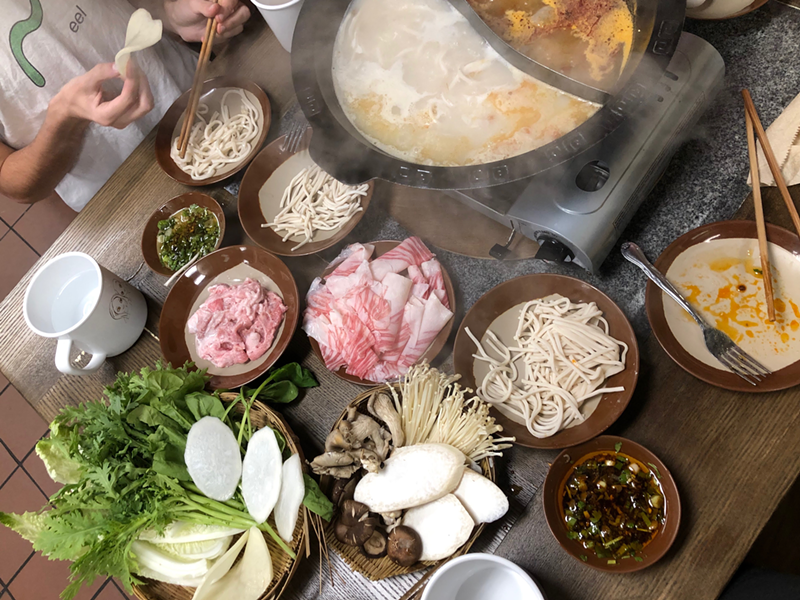While it might get stressful to have the whole family around a holiday table, one of the best parts of the winter season is what we eat together. Nobody can argue politics when their mouth is full of delicious food.
Some of Cincinnati’s favorite chefs sat down with CityBeat to describe winter dishes they can’t wait to eat every year so that we could interpret them into recipes you’re sure to love. Whether you’re looking for something exotic, inventive or downright comforting, there’s a good chance you’ll want to make a new tradition and eat one (or all) of these meals every year.
Hot Pot
Rich and Johnny Chu of AmerAsia
“Hot pot’s only served when you have unity at a gathering. On the day of Chinese New Year, that’s the only time an average family would get together and have hot pot. The hot pot is all to be determined on what your preference is. Some like to be heavy on the meat, some like to have it heavy on vegetables.” — Rich Chu, translated by Johnny Chu
The most important part of hot pot is the broth, according to Rich Chu, AmerAsia’s master chef. While he doesn’t speak much English, his son Johnny translated his thoughts on the dish that their entire family is excited to share each winter.
There are special pots designed just for hot pot, bisected down the center by a little wall to make two usable halves that hold different broths. If everyone at the table eats meat, the options typically include one spicy broth alongside a milder broth. If vegetarians are at the table, it’s normal to have a meaty broth in one half and a plant-based broth in the other. Of course, you could always use two pots instead if you don’t want to invest in specialty equipment, but make sure you have a heat source such as an electric range top or canned heat on the table to keep the broth boiling until the end of the meal.
Ingredients: A vegetarian or meat broth of your choice (ideally homemade); sliced chicken, pork, beef, lamb, shrimp or firm tofu or all of the above; an assortment of thinly sliced vegetables.
Instructions: This dish is served like fondue, where everyone sits around the bubbling broth, fills their bowls and continually dips their raw ingredients into the boiling liquid to cook them. Everything comes on a plate, thinly sliced. Chicken on one plate, pork on another. Beef, lamb and shrimp on are also popular proteins. All the veggies are kept separate from meat, so as not to contaminate them. Firm tofu is also a popular addition.
Any of your favorite vegetables can likely work with hot pot, just make sure they’re thinly sliced prior to serving to ensure they achieve a preferable texture when dunked in the boiling broth. Popular options include Napa cabbage, leeks, radish and various mushrooms like enoki and oyster.
Rice isn’t usually served with hot pot. The Chus’ preference is glass noodles. They say the noodles go well with hot pot because they’re so thin, cook quickly and don’t expand too much in your stomach. It’s not unusual to serve small bowls of chili-infused oil with hot pot if you want some added heat.
To drink: If the Chu family was back in Taiwan to eat hot pot, they’d drink Taiwan Beer, which for decades was the only beer legally brewed in the country due to its monopolistic government regulations. The best alternative to this beer in the Chus' eyes is the popular Tsingtao Beer. This crisp, light lager pairs well with the body-warming savoriness of hot pot.
Takha (Stewed Buffalo in Chilled Gravy)
Rose and Ashak Chipalu of Bridges Nepali Cuisine
“It melts in the mouth and we really relish that. We let it sit overnight so it jellies up while the meat stays down. All the gravy is like a jelly right on top.” — Rose Chipalu
Takha is a traditional dish prized by Rose Chipalu and her son Ashak of the Newari tribe from Nepal’s Kathmandu Valley. Made with stewed buffalo meat, this cool-weather food uses Nepal’s naturally chilly environment to let the flavors of all the components meld together as it sits covered on the counter overnight to achieve a gelatinous gravy (though we can’t legally recommend you leave meat on the counter overnight, so just opt for the fridge).
First, if you can’t find decent buffalo meat (preferably cut from the head and leg), Rose assures that beef is a suitable alternative, but encourages you to try the authentic recipe. Look for leaner cuts with minimal fat. Other recipes have used goat, too. No matter what meat you choose, always opt for the bones and skin to be included.
Ingredients: Meat, either beef, goat or buffalo; ginger; garlic; cumin; salt; turmeric; garlic; mustard oil or olive oil; cilantro.
Instructions: Add chopped meat, ginger, garlic, cumin, salt and turmeric to a large pot, cover with water and bring to boil. Reduce the heat to a bare simmer, cover and cook for eight to 12 hours. Remove the meat after the first three hours and set aside to avoid over stewing.
Add the meat to a bowl and cover with cooking liquid. This will sit in the fridge overnight.The next day the liquid will have gelatinized thanks to the collagen from the bones. The dish is garnished with chopped garlic, mustard oil (can substitute olive oil) and cilantro.
Typically, one quarter of the cooking liquid is reserved for a spicy gravy called sanya khuna. It’s made with fried anchovies and lots of spicy chili pepper mixed with the finished takha liquid and set overnight alongside the takha. There is no buffalo meat in sanya khuna, only fried anchovies in the gravy, which is garnished with a lot of red chili pepper powder.
Takah and sanya khuna are best served cold alongside basmati rice, cauliflower, marinated spinach or mustard greens and a potato dish. Visit one of Bridges’ two locations for inspiration on the side dishes.
To drink: To drink with takha, the Chipalus enjoy a strong milky rice ale that’s similar to unfiltered Japanese sake, which is likely your best substitute in our region.
Short Ribs Braised in Bordeaux Wine
Jose Salazar of Salazar, Mita’s and Goose & Elder
“I have been eating this dish since I first learned to make it in culinary school about 20 years ago. It reminds me of the excitement of being a young cook and learning new techniques and recipes. I do not associate it with a particular holiday — however, it does remind me of chilly winter nights.” — Jose Salazar
Ingredients: Short ribs, beef stock, Bordeaux wine, vegetable oil or rendered beef fat, celery, onion, carrot, garlic, salt.
Instructions: To properly braise meat, you must cook it low and slow partially submerged in flavorful liquids, in this case beef stock and red Bordeaux wine. Before you get started with anything else, preheat the oven to 325 degrees.
Brown the short ribs on the stove in a large Dutch oven with vegetable oil or rendered beef fat. This serves to create the caramelized brown bits on the bottom of the pot known as fond, which provide an incredible depth of flavor.
Once browned on all sides, remove the ribs and set aside. Add chopped aromatics such as celery, onion and carrot to the pot. Salazar likes this dish with plenty of garlic. Another hit of salt will bring out the moisture from the aromatics, which helps to deglaze the pot and incorporate the fond into the dish. After sweating on medium heat for several minutes, scrape the bottom of the pot with a wooden spoon to loosen the fond into the mix.
Replace the short ribs in the pot and add enough Bordeaux and beef stock to come up halfway to the top of the meat. Put a lid on the pot and cook in the oven until the meat falls off the bone, two to three hours to start, but don’t be surprised if more time is needed depending on the weight.
To make a pan sauce, strain out the cooking liquid and simmer in a saucepan until it’s reduced to your desired consistency.
To drink: Serve with a bottle of Bordeaux, of course.
Shish Barak (Dumplings in Yogurt Sauce)
Kate Zaidan of Dean’s Mediterranean Imports
“Lebanese food is great if you want really flavorful savory dishes. It’s layers of flavor. You always start with garlic and aromatics. Spices are really important, which is one of the reasons why my dad started a spice store.” — Kate Zaidan
Think of this dish as Mediterranean tortellini. You can go about this dish several ways, even buy frozen stuffed pasta to throw into the sauce, but the best dumpling is the one you’ve made yourself. Luckily, you can get everything you need for this dish from Dean’s Mediterranean Imports at Findlay Market. To make the dumplings, you can simply buy wonton wrappers or follow a basic flour-based dumpling dough recipe, but we’ve had no complaints from commercially available wraps in this application. For vegetarians, replace the ground meat with finely chopped mushroom, or buy mushroom tortellini for a convenient, luxurious meal.
Ingredients: Wonton wrappers, ground beef or lamb, cumin, coriander, salt, pepper, chopped cilantro, garlic, olive oil, Greek yogurt, one egg.
Instruction: Using either ground beef or lamb, saute the meat with a mixture of cumin, coriander, salt, pepper and chopped cilantro. When the meat is browned, set aside to cool. Start on the yogurt sauce while you wait for the meat to come down to room temperature. Alternately, the dumplings can be made days ahead and stored in the freezer.
In Lebanese cuisine, you don’t use a garlic press or chop the garlic; use a wooden mortar and pestle instead. It makes a paste out of the garlic. Add some olive oil to a high-walled pan and then lightly saute the garlic paste with cilantro. (The garlic can also be pulverized with the flat of your knife on a sturdy cutting board, just simply press the blade onto peeled garlic and smear across the board.)
Reduce the stovetop to low heat and mix the aromatics in the oil with Greek-style yogurt and whisk in one large egg to make the sauce. Season to taste. Add a bit of water if you prefer a thinner sauce. This can simmer on low while you prepare the dumplings.
Put a small ball of the ground meat in the middle of a wonton wrapper and fold it into your desired shape: a crescent moon, or a pope’s hat are popular starting points. Make sure the dumpling’s contents are totally sealed inside with no tears. Add to a salted pot of boiling water and cook. It’s better to err on the al dente side, since the dumplings will continue to cook when they’re added to the yogurt sauce.
Once the dumplings have achieved their desired texture, you can add them to the sauce on a low simmer. To plate, this dish is best served with an extra glug of olive oil on top with a garnish of parsley and a shake of red pepper flake.
To drink: A great drink to pair with this dish is strong Persian black tea brewed with a few sprigs of dried sage and sweetened with rock candy sugar cubes.






